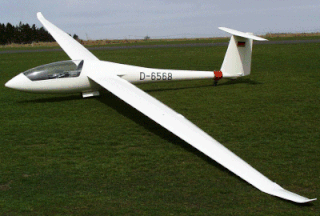This article needs additional citations for verification .(January 2013) |

Schempp-Hirth Flugzeugbau GmbH is a glider manufacturer based in Kirchheim unter Teck, Germany.
This article needs additional citations for verification .(January 2013) |

Schempp-Hirth Flugzeugbau GmbH is a glider manufacturer based in Kirchheim unter Teck, Germany.
Martin Schempp founded his own company in Göppingen in 1935, with the assistance of Wolf Hirth.
The company was initially called "Sportflugzeugbau Göppingen Martin Schempp". In 1938, Wolf Hirth, mainly responsible for the design work, officially became a partner in the company, which then became "Sportflugzeugbau Schempp-Hirth". The company relocated to Kirchheim unter Teck the same year.
The company's first product was the Göppingen Gö 1 Wolf glider, conceived as a rival to the ubiquitous Grunau Baby, but real success came with the Göppingen Gö 3 Minimoa the same year.
During World War II, the company built DFS Habicht training gliders, as well as tailplane assemblies for the Messerschmitt Bf 109. The company also built a research aircraft, the Göppingen Gö 9 to investigate Claude Dornier's rear-mounted "pusher" propeller plans. With its cruciform tail, this aircraft was to be a stepping-stone towards the revolutionary Dornier Do 335 Pfeil.
After the war, forbidden by the allied occupation from building aircraft, the company manufactured beds, wheelbarrows, radio cabinets, and other furniture. In 1951, the prohibitions were lifted and the company returned to sailplane building.
Wolf Hirth died in 1959 but it was not until 1964 that Martin Schempp found a new designer: Klaus Holighaus who had just graduated from Darmstadt Technical University, where he was a member of its Akaflieg. Holighaus was also an excellent pilot and became a regular member of the German gliding team.
Additional technical expertise was recruited in 1970 and Holighaus became Chief Executive in 1972. From 1977 Holighaus was the sole owner of the business.
After Holighaus's death in a gliding accident in 1994, control of the company passed to his widow and sons, all of whom are keen glider pilots.
It employs about 100 people, and is currently managed by Tilo Holighaus and Brigitte Holighaus.
The company has often sub-contracted work, and has issued licences for other companies to build its designs.
Schempp-Hirth aircraft include:

Wolfram Kurt Erhard Hirth was a German gliding pioneer and sailplane designer. He was a co-founder of Schempp-Hirth, still a renowned glider manufacturer.

The Göppingen Gö 1 Wolf was a single-seat glider produced in Germany from 1935.

The Schempp-Hirth Discus is a Standard Class glider designed by Schempp-Hirth. It was produced in Germany between 1984 and 1995 but has continued in production in the Czech Republic. It replaced the Standard Cirrus. It was designed by Klaus Holighaus.

The Schempp-Hirth Ventus is a sailplane produced during 1980–1994 by Schempp-Hirth, a German sailplane manufacturer. It was designed by Klaus Holighaus and replaced the Schempp-Hirth Mini-Nimbus. Schempp-Hirth manufactured 613 Ventus sailplanes.

The Schempp-Hirth Mini Nimbus is a 15 Metre-class glider designed and built by Schempp-Hirth GmbH in the late 1970s.
Klaus Holighaus was a glider designer, glider pilot and entrepreneur.

The Standard Cirrus is a German Standard-class glider built by Schempp-Hirth. The Standard Cirrus was produced between 1969 and 1985, when it was replaced by the Discus. Over 800 examples were built, making it one of the most successful early fibreglass glider designs.

The Schempp-Hirth Cirrus is an Open Class glider built by Schempp-Hirth between 1967 and 1971 and by VTC until 1977. It was replaced by the Nimbus 2.

The Schempp-Hirth Nimbus-2 is an Open Class glider built by Schempp-Hirth during the 1970s. The Nimbus-2 first flew in April 1971 and a total of over 240 examples of all subtypes have been built until the beginning of the 1980s. It replaced the Schempp-Hirth Cirrus.

The Schempp-Hirth Nimbus 3 is a glider built by Schempp-Hirth.
Competition classes in gliding, as in other sports, mainly exist to ensure fairness in competition. However the classes have not been targeted at fostering technological development as in other sports. Instead classes have arisen because of:
Contrary to the methods used by the Reich Air Ministry (RLM) for the allocation of aircraft designations, the designers and manufacturers of sailplanes and gliders in Germany enjoyed the freedom of choosing their own designations for their products up until 1945.
The European Gliding Championships is a gliding competition held every two years.
The Hirth Hi 20 MoSe was a German motor glider designed in the late 1930s. Based on the Göppingen Gö 4 side-by-side seat training glider, it had a foldaway propeller, column-mounted above the fuselage and shaft-driven by a small internal piston engine.

The Schempp-Hirth Ventus-3 is a sailplane produced by Schempp-Hirth. It replaces the highly successful Schempp-Hirth Ventus-2.
| Wikimedia Commons has media related to Schempp-Hirth . |